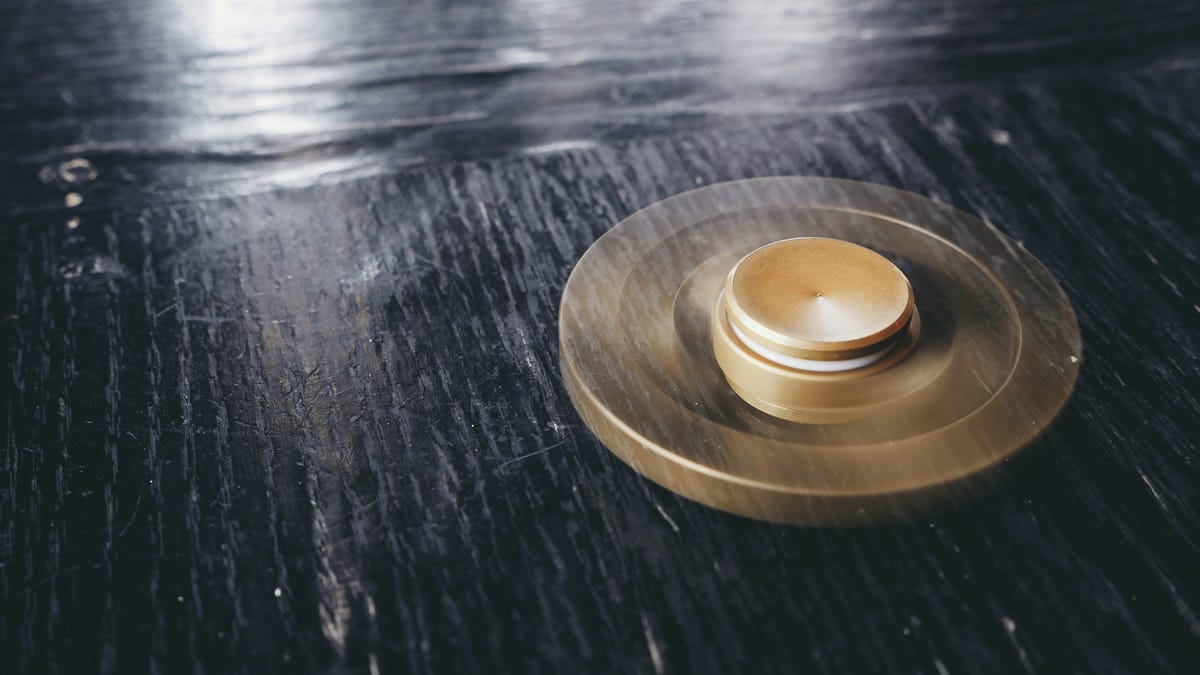 Why You Can Trust CNET
Why You Can Trust CNET Fidget spinners: How to buy or DIY the latest distraction toy
You've seen them everywhere. What are fidget spinners and why do you want one?

Fidget spinners -- much like Rubik's Cubes, pet rocks and Tech Decks (aka fingerboards) -- are the newest way to distract yourself with something other than your phone.
Since December, the finger toys have infiltrated classrooms, taken Amazon's Toys & Games section hostage and have me spinning an expensive piece of brass between my finger as I write this.
No one can seem to track down where they came from or figure out why they're suddenly so popular. And I can't, for the life of me, put mine down.
Here is everything you need to know about fidget spinners.
What are fidget spinners?
A fidget spinner is just a frame surrounding a ball bearing in the center. While holding the bearing -- or a button covering the bearing -- one of the sides of the frame is flicked, and the spinner will, well... spin.
Fidget spinners aren't only marketed as fun toys, they're also aimed directly at adults who struggle with focus and stress or suffer from ADHD. They're small, discreet toys you might keep by your computer to keep from incessantly clicking your pen or otherwise fidgeting with something noisy and distracting to those around you.
They come in various shapes and designs, typically with two to five legs and usually only 1 to 3 inches (2.54 to 7.62 centimeters) wide. They're made of either plastic or metal and the price range stretches from a couple bucks to upward of $700 (£541.63 or AU$953.68). Some of the more bizarre designs feature trippy visuals as they spin.
Why are they suddenly popular?
How the fidget spinner came to be or who originally created it is up for debate.
I've been fiddling with the $80 hunk of brass in my pocket, the Rotobow (with some custom brass buttons), for over six months now. I didn't realize fidget spinners had become so popular until about a month ago.
One possibility is that the fidget spinner was created back in 1993 by Catherine Hettinger. But the tale of how her invention came to be changed between her interviews with The Guardian and with CNN Money. Plus, what Hettinger created and what we now call a fidget spinner are quite different. Her spinner looks more like a small, misshapen frisbee.
I first came across a fidget spinner while browsing "pocket dumps" from everyday carry enthusiasts. It wasn't until December, after being listed as "the must-have office toy for 2017" by Forbes, that spinners began appearing everywhere for just a couple bucks each.
Between the second half of 2016 and today, the Google Trends graph for "fidget spinner" is a sharp upward curve -- almost a 90-degree angle. This can be linked to a combination of fidget spinners becoming more affordable and available and children seeing other kids incessantly spinning the toys between their fingers.
Regardless of why fidget spinners are so popular, people can't seem to agree on whether they're helpful or distracting for those suffering from focus issues and schools around the US have banned them. But their popularity isn't showing any signs of slowing.
How to buy a fidget spinner
Before December 2016, if you wanted a fidget spinner your options were limited. You could find a few handmade spinners on Etsy, but they were often out of stock or expensive. Now, it's much harder to avoid spinners.
The other day, my mom bragged to me that she bought herself a fidget spinner at Walgreens.
You can find them all over Amazon, at a nearby convenience store or retailer or easily make one yourself.
Make one yourself
One of the easiest ways to test out a fidget spinner is to make one yourself. All you need is a ball bearing and a few other easy-to-find materials. One common DIY fidget spinner (seen above) is one I made using pipe fittings. I made another with cable ties.
People have made fidget spinners out of coins, welded nuts, plexiglass, Popsicle sticks and many other common materials.
Buy one from Amazon
Fidget toys currently hold 82 out of the top 100 best-seller spots in Amazon's Toys & Games section. Of those, 74 are fidget spinners and 8 are knock-off fidget cubes.
On Amazon, hand spinners can be found in just about any color, shape, design or material you want. If you want yours to last a while, choose a model made of a robust material, like metal.
Check your local convenience store
More and more, fidget spinners are making their way into convenience stores and stores like Walgreens and CVS. Some larger retailers, such as Walmart, are beginning to carry spinners, as well. They can generally be found near the cash registers.
Quality spinners are found on Etsy and Instagram
It may sound silly, but people do spend a lot of money on fidget spinners. And some makers put a lot of effort into making the best spinners around, be it using a premium material like titanium or using more expensive ceramic bearings.
If you prefer your spinner to be hand crafted out of ebony or precision machined of brass or copper, you'll need to peruse Etsy or Instagram to find indie spinner makers who charge anywhere between $20 and $500.

